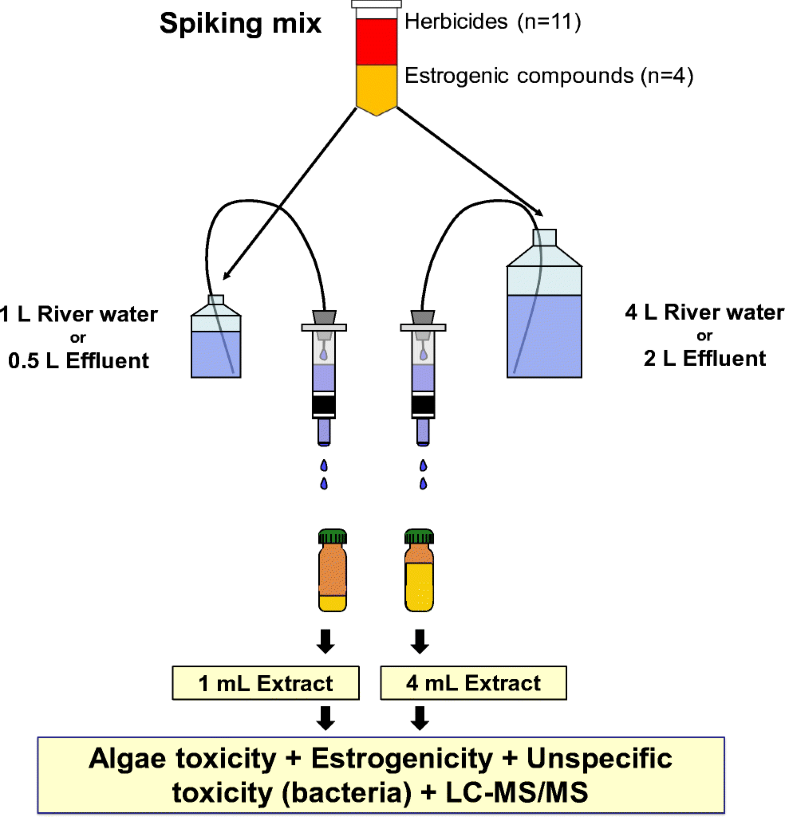Analytical and Bioanalytical Chemistry ( IF 4.3 ) Pub Date : 2019-02-08 , DOI: 10.1007/s00216-019-01628-1 Eszter Simon , Andrea Schifferli , Thomas B. Bucher , Daniel Olbrich , Inge Werner , Etiënne L. M. Vermeirssen
Ecotoxicological screening of surface waters can involve multiple analyses using multiple bioassay and chemical analytical methods that require enriched samples to reach low concentrations. Such broad screening of the same sample necessitates sufficient sample volume—typically several liters—to produce a sufficient amount of enriched sample. Often, this is achieved by performing parallel solid-phase extractions (SPE) where extracts are combined into a pool—this is a laborious process. In this study, we first validated our existing SPE method for the chemical recovery of an extended set of compounds. We spiked four estrogenic compounds and 11 herbicides to samples from independent rivers (1 L) and wastewater treatment plant effluents (0.5 L). Then, we investigated the effect of increased sample loading of the SPE cartridges on both chemical and biological recoveries by comparing the validated volumes with four times larger sample volumes (i.e., 4 L river water and 2 L effluent). Samples were analyzed by LC-MS/MS and three bioassays: an estrogen receptor transactivation assay (ERα-CALUX), the combined algae test, and a bacterial bioluminescence inhibition assay. Our existing SPE method was found to be suitable for enriching the extended set of estrogens and herbicides in river water and effluents with near to perfect chemical recoveries (~ 100%), except for the herbicide metribuzin (46 ± 19%). In the large volume river and effluent samples, the biological activities and concentrations of the spiked compounds were between 87 and 104% of those measured with the lower sample loading, which is adequate. In addition, the ratio between the large and original volume SPE method for the non-target endpoint (bacterial bioluminescence inhibition) was acceptable (on average 82 ± 9%). Results indicate that our current water extraction method can be applied to up to four times larger sample volumes, resulting in four times more extract volumes, without significant reductions in recoveries for the tested estrogens and herbicides.

ᅟ
中文翻译:

从环境水中固相提取雌激素和除草剂以进行生物分析—样品量对回收率的影响
地表水的生态毒理学筛选可能涉及使用多种生物测定和化学分析方法进行的多种分析,这些方法需要浓缩的样品才能达到低浓度。对相同样品的如此广泛的筛选需要足够的样品量(通常为几升)才能产生足够量的富集样品。通常,这是通过执行并行固相萃取(SPE)来实现的,其中将萃取物合并到一个池中-这是一个费力的过程。在这项研究中,我们首先验证了我们现有的SPE方法可用于扩展化合物的化学回收率。我们在来自独立河流(1升)和废水处理厂废水(0.5升)的样品中加入了四种雌激素化合物和11种除草剂。然后,我们通过将已验证的体积与四倍大的样品体积(即4 L的河水和2 L的废水)进行比较,研究了SPE柱的样品加载量增加对化学和生物回收率的影响。通过LC-MS / MS和三种生物测定法分析样品:雌激素受体反式激活测定法(ERα-CALUX),组合藻类测定法和细菌生物发光抑制测定法。我们现有的固相萃取方法被发现适合于在河水和废水中富集扩展的雌激素和除草剂,化学回收率几乎达到理想水平(〜100%),除草剂甲丁净(46±19%)除外。在大体积的河流和废水样品中,加标化合物的生物活性和浓度为较低样品量时的生物活性和浓度的87%至104%,这是足够的。此外,用于非目标终点(细菌生物发光抑制)的大体积SPE方法与原始体积SPE方法之间的比率是可以接受的(平均82±9%)。结果表明,我们目前的水提取方法最多可应用于四倍大的样品量,导致四倍的提取量,而测试雌激素和除草剂的回收率却没有显着降低。

ᅟ



























 京公网安备 11010802027423号
京公网安备 11010802027423号